Home Page / My Brush With Page / John Paul II / Benedict-Francis
Introduction
My religion has, of course, over the years been an enormous influence on me - I have embraced it as each good young child should, I have reviled it in moments of ... what .... uncertainty? Perhaps more so in moments of ... frustration. I have returned to the fold and been welcomed back - now I have the capacity to sing out to the world about my religion! I am a Roman Catholic and proud of it! My mother was born in Kraków and we have strong ties with some members of the family - not as many as previously through death and through that natural breaking away process that we experience as we forge our own lives, continents apart. Sad, but true. And the biggest link there is with Kraków's former Cardinal - Karol Wojtyła, more famously known as Giovanni Paolo II (John Paul II) - now canonised as St. John Paul II
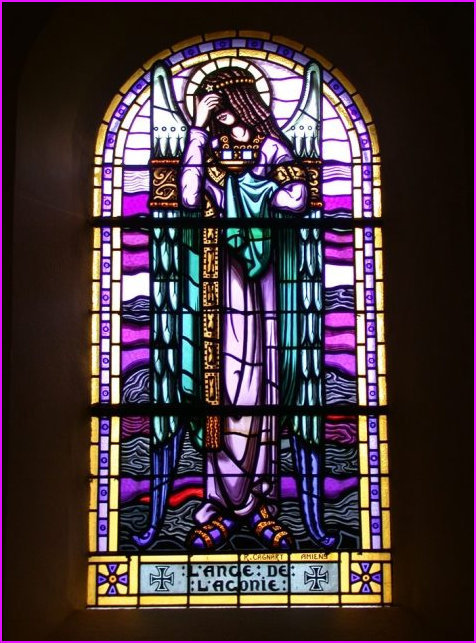
L'Ange de L'Agonie - Angel of Agony stained glass window - potentially French early 20th Century
The Angel of the Agony is the angel who ministered to Jesus on the cross. With his legions, the Angel of the Agony inspires and uplifts those who are weighted down with the weight of the cross of personal and planetary karma. He exemplifies the many angels who minister to suffering humanity. This angel asks to be remembered when we are praying for those who are suffering. Source : summitlighthouse.org
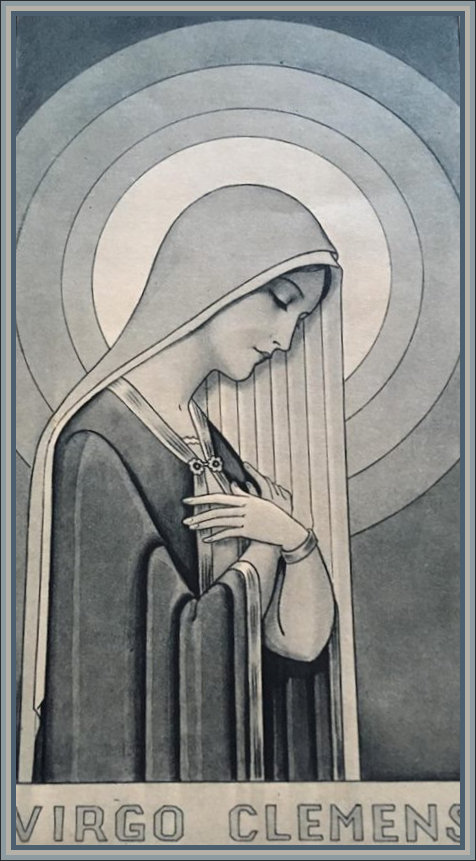
'Merciful Virgin' usually followed by 'Pray for Us' possibly 'Have Mercy on us' - this beautiful evocation of the Virgin Mary is my way of paying tribute to St. John Paul II who held the Mother of God in such high regard and dedicated himself to her. The image is widely reproduced on Pinterest and some religious/Roman Catholic sites, usually with the words 'Virgo Clemens' removed.
But such mysteries does our Church offer us - not least the ongoing debate about the origins of :
The Turin Shroud really could be Christ's burial robe, say scientists
Tuesday, 20th December 2011 - The Telegraph
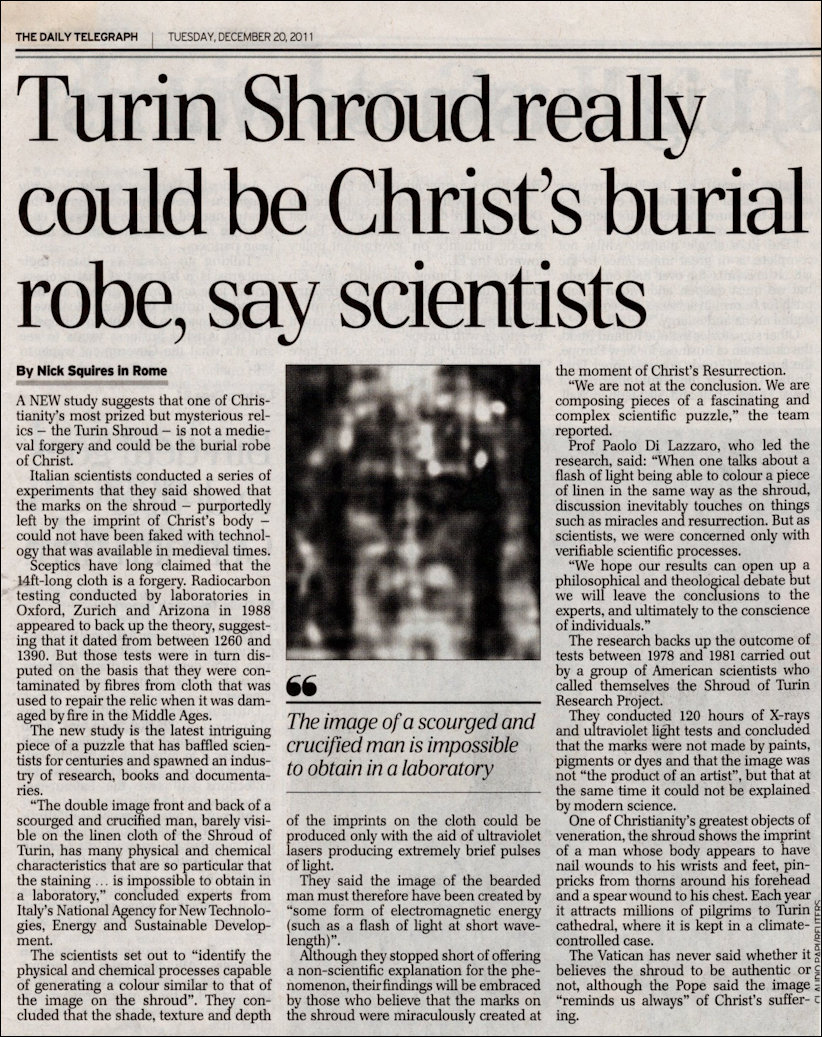
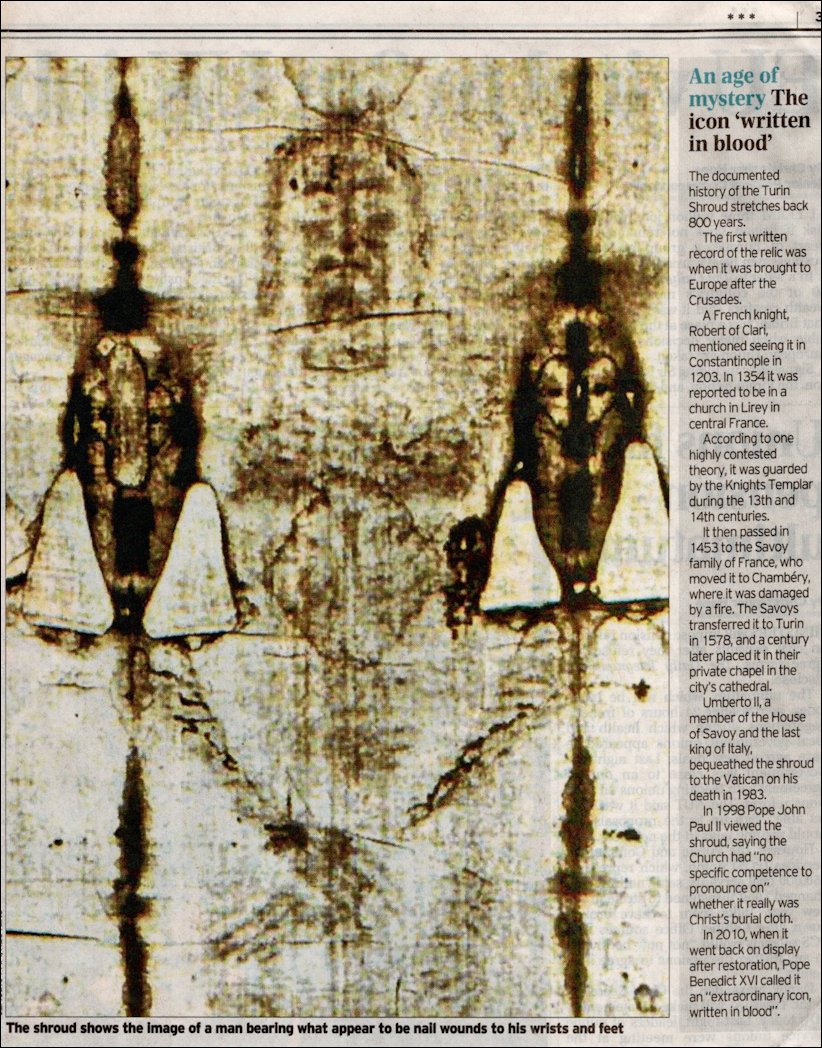
To a believer, the Shroud will always be what you can see .....
The Turin Shroud - this is one mystery that will never go away!
Still in the news in December 2011 as new evidence is unearthed.
The following is reproduced from the Daily Mail dated 22nd December 2011
"The Turin Shroud DOES have miraculous powers... whether it is genuine or not"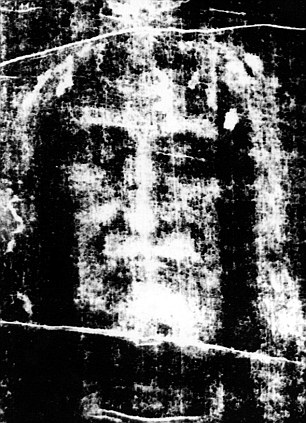
By PETER STANFORD - Last updated at 10:05 AM on 22nd December 2011
Italian scientists claim shroud was created by 'supernatural event' as burst of ultra-violet light necessary to leave imprint on cloth wasn't then possible. Implication from research is that image of Jesus was scorched onto linen by divinely generated light given out by His body Shroud believers welcome new scientific research 'proving' its existence But Vatican still refuses to comment on the long-running saga
Puzzle: The Turin Shroud's origin is endlessly debated. Still, the Catholic Church has placed the cloth in a cathedral as an object of worship The Catholic Church has never publicly accepted or rejected popular belief that the Turin Shroud is the burial cloth of Jesus Christ.
But it has done everything short of that to encourage devotion to this ancient piece of linen, on display in Turin Cathedral, which bears the markings of a man who appears to have been crucified. The extraordinary sepia image on the cloth is simply — as Pope Benedict XVI likes to put it in that careful, precise way of his — ‘an image that reminds us always of Christ’s suffering’.
Yet, this week, a group of Italian scientists claimed the shroud was created by a ‘supernatural event’ rather than the machinations of medieval forgers. The academics concluded that the sort of burst of ultra-violet light necessary to have left such an imprint on the cloth just wasn’t possible by any human endeavour in any age other than our own technically advanced one with its access to lasers. The implication of their findings is that the image was scorched on to the linen as a result of a divinely generated light given out by Jesus’s body when he rose from the dead. Believers in the shroud hail the research by scientists at Italian National Agency for New Technologies, Energy and Sustainable Economic Development (ENEA) as proof that it is genuinely the cloth of Christ. They claim it backs up the work of a group of American scientists from the Shroud of Turin Research Project (STURP) from the Seventies.
These scientists established by careful analysis of the fibres of the cloth that the image of the bearded, crucified man had not been painted on to the cloth. It was not, they concluded, ‘a natural formation’. Science, say the believers, appears to have provided no reasonable answer to counter the belief of generations of Christians that this is the image of Christ on the shroud in which his body was wrapped when it was taken down from the cross.
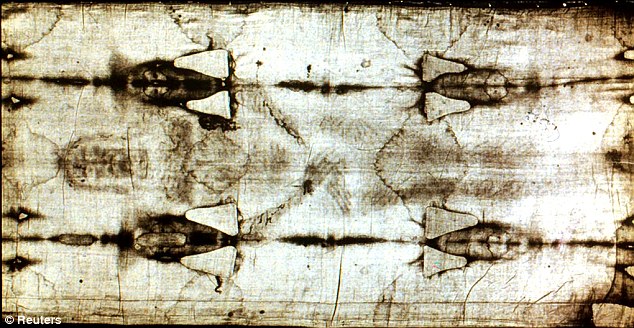
Scientists in Italy believe the kind of technology needed to create the Shroud of Turin simply wasn't around at the time that it was created. Still the Vatican steadfastly refuses to be drawn again into the saga.
And yet, despite this latest research supposedly proving its authenticity, the Vatican has steadfastly refused to be drawn again into the long-running saga of the shroud.
The question is why. Why, if the science seems so certain, won’t the Catholic Church endorse this piece of cloth as the genuine article?
One reason is that the new research still cannot get round the main stumbling block when it comes to proving the shroud’s authenticity.
In 1988, three separate and internationally acclaimed laboratories in Zurich, Oxford and Arizona carbon-dated samples of the cloth, provided by the Church, and came up with 1260 to 1390 as its probable date of origin. In other words, that research showed it to be a medieval forgery.
And in the 23 years since, the best that the shroud’s devotees have come up with to counter this incontrovertible fact is a theory that all three samples that were carbon-dated were contaminated — that they contained rogue fibres from later medieval attempts to patch and mend the original shroud. There are plenty of papers that try to make this thesis stand up, but the overall impression is of whistling in the wind. So why do people flock to see the shroud on the rare occasions it is put on public show in its glass, climate- controlled display case? The most straightforward answer is that we like a mystery and this one is about as tantalising as it gets. For just as the Church has never felt able to pronounce definitively on the shroud, neither has science come up with a water-tight theory as to exactly what it is and how the image came about. The shroud therefore exists in a kind of middle ground — where we can all pronounce our own verdict. But once you start considering the possibilities of how it was created, you immediately get in a tangle.
If it is a medieval forgery, then how can its image have been created by methods beyond the wit of humankind at that time?
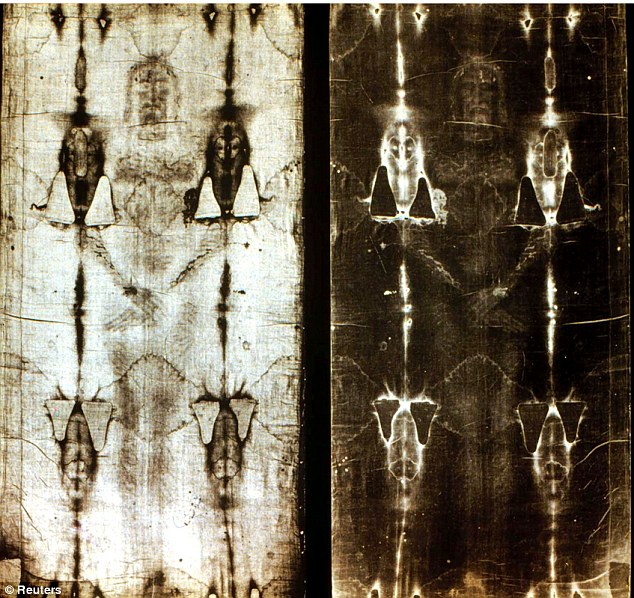
Why do people flock to see the shroud? We like mystery. Since neither the church nor science have come up with a definitive answer, the shroud exists in middle ground, where we can make our own verdict. One of the most intriguing aspects is that the image of Christ is hard to pick out with the naked eye in the sepia markings on the cloth, which is 4½m long and just over a metre in width. But, when at the very end of the 19th century, a photographic negative of the image was first produced, it looked every inch like the face of Christ. How could a medieval forger have produced something so exact 500 years before the technology existed to make a negative image? Yet the sceptics could easily counter this with an argument of their own.
Even if the shroud is really 2,000 years old and the carbon-dating laboratories mistaken, they point out what is there to link it to Jesus?
Crucifixion was a common method of putting criminals to death back under the Romans. This might just as well be the funeral wrappings of a run-of-the-mill murderer or thief. Indeed, one theory popular among supporters of the medieval forgery theory is that it was made centuries after the death of Christ by crucifying someone in exactly the same manner as described in the Gospel accounts and then wrapping the victim in a shroud. The further you go into this mystery, the murkier the waters become.
And if you go so far as to visit Turin (for 500 years the shroud belonged to the locally based royal house of Savoy) and stand in front of the display case, there is undeniably a certain awe about this object.
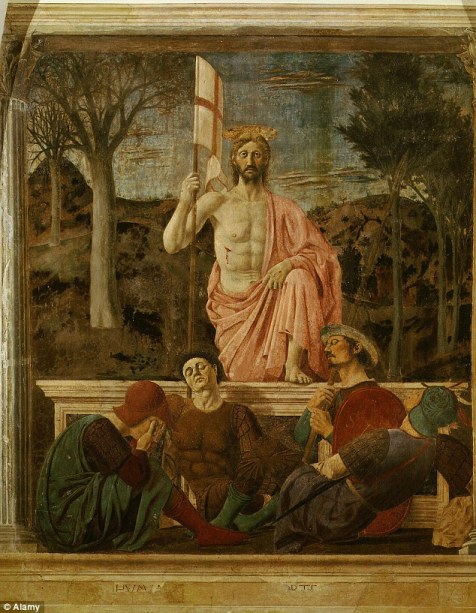
The Resurrection of Christ, 1463-65, fresco by Piero della Francesca: The Vatican - which owns the Turin shroud - shies away from statements over whether it is real or fake, but says it helps to explore the 'darkest mysteries of faith'. It springs, to my mind, not from any air of authenticity that the object itself radiates, but from the knowledge that for centuries people have been making precisely the same pilgrimage as I and so many others have done to gaze at this piece of cloth. It stems from the fact that they have harboured exactly the same hopes that by doing so, somehow, they will be able to reach a final conclusion on the truth or not of the very claims of Christianity.
How comforting it would be to know, for sure, if there is a God. What is important today about the shroud is not whether it is genuinely the burial cloth of Jesus — we are never going to reach a consensus on that — but rather that over many centuries people have believed in it. It is this history of belief that is the really powerful thing. At a stroke it carries us back through centuries of Christianity and connects our sceptical, secular and scientific age with an earlier epoch of miracles and faith.
This is why the Catholic Church refuse to be drawn on the Turin Shroud.
As Pope Benedict says, it is an extraordinarily powerful image of Christ’s suffering — and made so because of the faith people have in it, whether it is genuine or not. On its own, the shroud is never going to be enough to legitimise belief in the core tenet of Christianity — the Resurrection of Jesus. But nevertheless, it is a powerful focus for our thoughts on the subject — a symbol of the hopes of so many who embrace Christianity without any conclusive proof other than their own belief. And that, surely, is the point about religion — a point we are in danger of missing now that every belief and theory is judged to be worthless unless it can be put under a microscope by scientists and proved, irrefutably, to be true.
Some things, some important things, just don’t fit into this rigid, logical model of the world.
Science, as the saga of the shroud epitomises, can never get to the bottom of faith.
Peter Stanford is a former editor of the Catholic Herald. His latest book, The Extra Mile: A 21st Century Pilgrimage, is published by Continuum.
Is this the face of Jesus as a boy? Italian police reverse the ageing process on image taken from the Turin Shroud to create photo-fit of Christ as a young child
Police used computer forensic techniques that help to catch mafia bosses
Image was created to mark new exhibition of Christ's supposed burial cloth
By Simon Tomlinson for MailOnline | 10:49, 5 May 2015 | 15:28, 5 May 2015
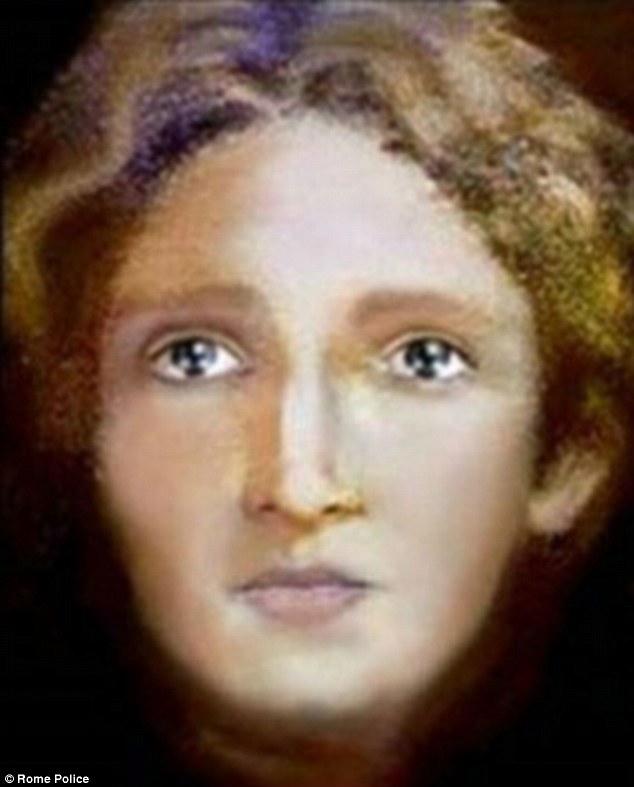
Youthful: Italian police claim this is what Jesus Christ looked like as a young boy
This is the face of Jesus Christ as a child – according to Italian police. Detectives used computer forensic techniques that have helped to catch mafia bosses to generate the image. First, they created a photo-fit picture from the facial image in the Turin Shroud, which many believe to be that of Jesus. They then used a computer program to reverse the ageing process by reducing the jaw size, slimming the face and softening the eyes to arrive at the younger Christ.
Italian police use the same digital techniques, but in reverse, to create updated photo-fit images of fugitive mafia bosses whose faces have not been seen for years. This was successfully achieved in the case of Bernardo Provenzano who was captured in 2006 after his image was re-created on a picture from 1959, it was reported by The Independent.
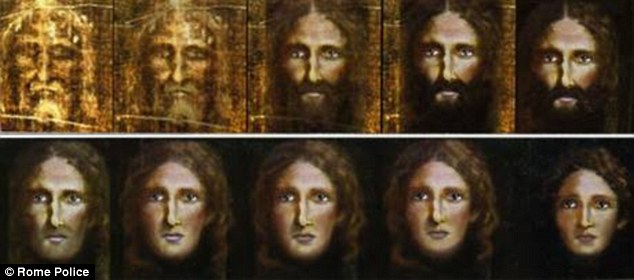
Winding back the years: Detectives used a computer program to reverse the ageing process on an image from the Turin Shroud (top left) to arrive at the younger Christ (bottom right)
The image of the young Jesus was created to coincide with the latest exhibition of the Turin Shroud at Turin Cathedral which is expected to attract millions of visitors, including Pope Francis. Debate rages over the authenticity of the Shroud, which is imprinted with the image of a man who appears to have been crucified. In 1998, the shroud was carbon dated to the end of the 13th century, lending support to those who say it is a medieval forgery. But it has retained its mystical air for many thanks partly to the fact that researchers have been unable to establish exactly how the image was created. The Church does not officially maintain that Christ's body was wrapped in the shroud or that any miracles were involved in the creation of the image now on display.
'It is not a profession of faith because it is not an object of faith, nor of devotion, but it can help faith,' Turin Archbishop Cesare Nosiglia said last month.
Local authorities are counting on the exhibition of the shroud in the city's cathedral to give a significant boost to the local economy at a time of stagnation across Italy. When the shroud was last presented to the public, in 2010, more than two million people filed past it. Pope Francis decreed the latest exhibition to mark the 200th anniversary of the birth of St John Bosco, a 19th century monk who devoted his life to the education of poor children in newly-industrialised Turin. Francis, who has family roots in the region, is due to visit the city and the exhibition on June 20-21.
The shroud will be on display for 12 hours a day between 7.30am and 7.30pm with an entry free. Viewers will be afforded only a few minutes each in front of the original although they will be able to linger longer at a specially-made model and a related exhibition.
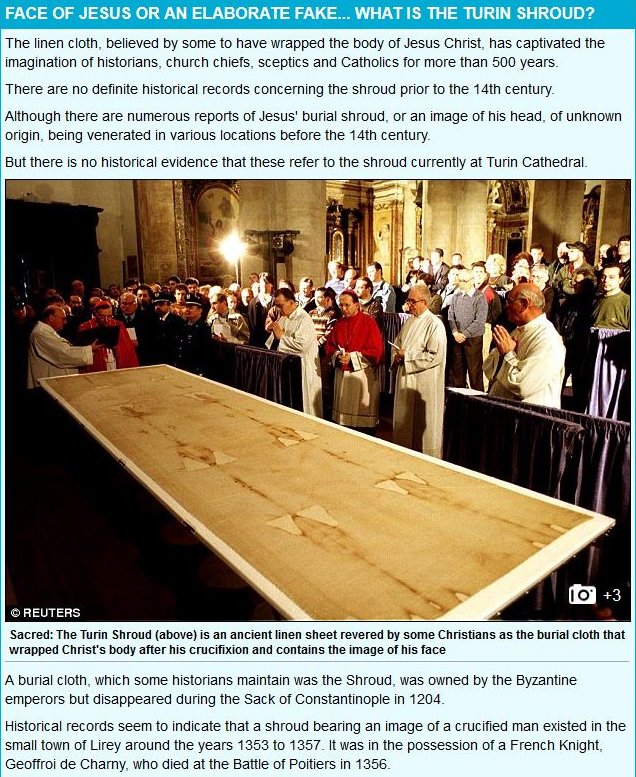
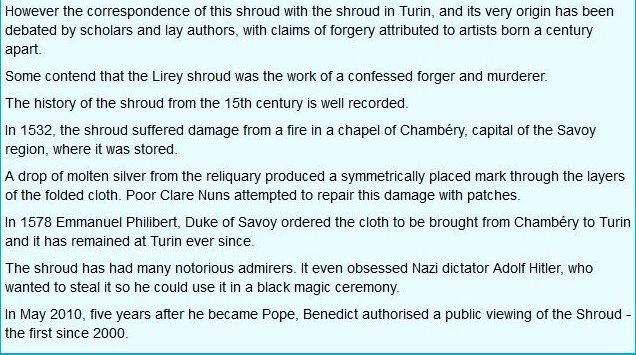
With thanks to the Daily Mail for the photo-montage information.
Page refreshed : 14th October 2020 (G)